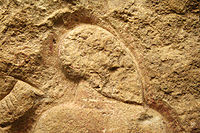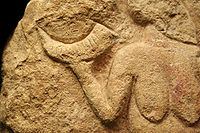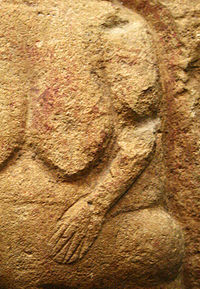
Venus of Laussel
Encyclopedia




Venus figurines
Venus figurines is an umbrella term for a number of prehistoric statuettes of women portrayed with similar physical attributes from the Upper Palaeolithic, mostly found in Europe, but with finds as far east as Irkutsk Oblast, Siberia, extending their distribution to much of Eurasia, from the...
, a 1.5 foot high limestone
Limestone
Limestone is a sedimentary rock composed largely of the minerals calcite and aragonite, which are different crystal forms of calcium carbonate . Many limestones are composed from skeletal fragments of marine organisms such as coral or foraminifera....
bas-relief of a nude female figure, painted with red ochre
Ochre
Ochre is the term for both a golden-yellow or light yellow brown color and for a form of earth pigment which produces the color. The pigment can also be used to create a reddish tint known as "red ochre". The more rarely used terms "purple ochre" and "brown ochre" also exist for variant hues...
. It is related to Gravettian
Gravettian
thumb|right|Burins to the Gravettian culture.The Gravettian toolmaking culture was a specific archaeological industry of the European Upper Palaeolithic era prevalent before the last glacial epoch. It is named after the type site of La Gravette in the Dordogne region of France where its...
Upper Paleolithic
Upper Paleolithic
The Upper Paleolithic is the third and last subdivision of the Paleolithic or Old Stone Age as it is understood in Europe, Africa and Asia. Very broadly it dates to between 40,000 and 10,000 years ago, roughly coinciding with the appearance of behavioral modernity and before the advent of...
culture (approximately 25,000 years old).
The figure holds a wisent
Wisent
The wisent , Bison bonasus, also known as the European bison or European wood bison, is a species of Eurasian bison. It is the heaviest surviving land animal in Europe; a typical wisent is about long, not counting a tail of long, and tall. Weight typically can range from , with an occasional big...
horn, or possibly a cornucopia
Cornucopia
The cornucopia or horn of plenty is a symbol of abundance and nourishment, commonly a large horn-shaped container overflowing with produce, flowers, nuts, other edibles, or wealth in some form...
, in one hand, which has 13 notches. According to some researchers, this may symbolize the number of moons or the number of menstrual cycle
Menstrual cycle
The menstrual cycle is the scientific term for the physiological changes that can occur in fertile women for the purpose of sexual reproduction. This article focuses on the human menstrual cycle....
s in one year.
Alexander Marshack
Alexander Marshack
Alexander Marshack was an American independent scholar and Paleolithic archaeologist. He was born in The Bronx and earned a bachelor's degree in journalism from City College of New York, and worked for many years for Life magazine.-Archaeology career:Despite lacking a PhD, Marshack became a...
said about the Venus of Laussel that "One cannot conjecture on the basis of one engraved sequence any meaning to the marks, but that the unusually clean horn was notated with storied marks is clear."
She has her hand on her abdomen (or womb), with large breast
Breast
The breast is the upper ventral region of the torso of a primate, in left and right sides, which in a female contains the mammary gland that secretes milk used to feed infants.Both men and women develop breasts from the same embryological tissues...
s and vulva
Vulva
The vulva consists of the external genital organs of the female mammal. This article deals with the vulva of the human being, although the structures are similar for other mammals....
. There is a "Y" on her thigh and her faceless head is turned toward the horn.
The figure was rediscovered in 1911 by J. G. Lalanne, a physician. It was carved into large block fallen in a limestone rock shelter (abri de Laussel) on the territory of the commune of Marquay
Marquay, Dordogne
Marquay is a commune in the Dordogne department in Aquitaine in southwestern France.-Population:-See also:* Château de Puymartin* Venus of Laussel, discovered in Marquay* Communes of the Dordogne department-References:*...
, in the Dordogne
Dordogne
Dordogne is a départment in south-west France. The départment is located in the region of Aquitaine, between the Loire valley and the High Pyrénées named after the great river Dordogne that runs through it...
department of southwestern France
France
The French Republic , The French Republic , The French Republic , (commonly known as France , is a unitary semi-presidential republic in Western Europe with several overseas territories and islands located on other continents and in the Indian, Pacific, and Atlantic oceans. Metropolitan France...
. It is now in the Musée d'Aquitaine, in Bordeaux
Bordeaux
Bordeaux is a port city on the Garonne River in the Gironde department in southwestern France.The Bordeaux-Arcachon-Libourne metropolitan area, has a population of 1,010,000 and constitutes the sixth-largest urban area in France. It is the capital of the Aquitaine region, as well as the prefecture...
, France.

